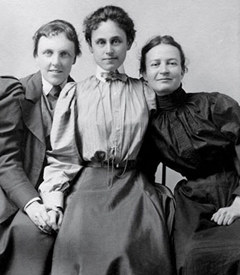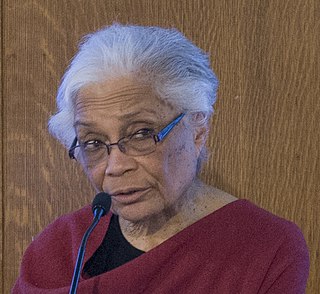Related Research Articles

Theodate Pope Riddle was an American architect and philanthropist. She was one of the first American women architects and a survivor of the sinking of the RMS Lusitania.

Marion Mahony Griffin was an American architect and artist. She was one of the first licensed female architects in the world, and is considered an original member of the Prairie School. Her work in the United States developed and expanded the American Prairie School, and her work in India and Australia reflected Prairie School ideals of indigenous landscape and materials in the newly formed democracies. The scholar Debora Wood stated that Griffin "did the drawings people think of when they think of Frank Lloyd Wright ." According to architecture critic, Reyner Banham, Griffin was "America’s first woman architect who needed no apology in a world of men."

Michael David Sorkin was an American architectural and urban critic, designer, and educator. He was considered to be "one of architecture's most outspoken public intellectuals", a polemical voice in contemporary culture and the design of urban places at the turn of the twenty-first century. Sorkin first rose to prominence as an architectural critic for the Village Voice in New York City, a post which he held for a decade throughout the 1980s. In the ensuing years, he taught at prominent universities around the world, practiced through his eponymous firm, established a nonprofit book press, and directed the urban design program at the City College of New York. He died at age 71 from complications brought on by COVID-19 during the COVID-19 pandemic.

Denise Scott Brown is an American architect, planner, writer, educator, and principal of the firm Venturi, Scott Brown and Associates in Philadelphia.

The New York School of Applied Design for Women, established in 1892 by Ellen Dunlap Hopkins, was an early design school for women in New York City. The 1908 New York School of Applied Design building was designed by Harvey Wiley Corbett and is now landmarked.
Jeffrey Karl Ochsner is an architect, architectural historian, and professor at the University of Washington in Seattle. He is known for his research and writing on American architects Henry Hobson Richardson and Lionel H. Pries, and on Seattle architecture; he has also published articles that link architecture and psychoanalysis.

Sharon Egretta Sutton, is an American architect, educator, visual artist, and author. Her work is focused on community-based participatory research and design. She is a professor emerita at the University of Washington. In 1984, she became the first African American woman to become a full professor in an accredited architectural degree program while teaching at the University of Michigan. She has also taught at Parsons School of Design, and Columbia University.

Josephine Wright Chapman (1867–1943) was a pioneering woman architect, one of fewer than 100 practicing nationally in the first half of the 20th century. She was also the first woman architect "in the history of American architecture to start and head her very own firm," which she accomplished at the tail end of the 19th century. Practicing both in Boston and New York, she got her start as an apprentice in the prestigious Blackall, Clapp and Whittemore firm. Her first practice opened in 1897 in Grundmann Studios, a Boston-based women's art collective. A member of the New York Society of Architects, and one of only 70 female architects in the United States at the time, she was refused admission by both the American Institute of Architects and the Boston Architectural Club on the basis of her gender. Nonetheless, her repertoire soon included "churches, clubs, libraries, and apartments, as well as the Women’s Clubs in Lynn and Worcester, Massachusetts." Chapman's second practice was founded in New York, and that's when her career really took off,"[a]s confirmed by The Ladies’ Home Journal, which noted her popularity: “You can find her [Chapman’s] work everywhere in the environs of New York…”
Margaret Goodin Fritsch was an American architect. In 1923 she became the first female graduate of the University of Oregon School of Architecture and in 1926 she became the first licensed female architect in the state of Oregon. She went on to run her own architecture firm and eventually served as a city planner in Alaska.

Ethel Bailey Furman was an American architect who was the earliest known African-American female architect in Virginia.
Sarah Wigglesworth MBE RDI is a British award-winning architect and was a Professor of Architecture at the University of Sheffield until 2016.

Women in architecture have been documented for many centuries, as professional practitioners, educators and clients. Since architecture became organized as a profession in 1857, the number of women in architecture has been low. At the end of the 19th century, starting in Finland, certain schools of architecture in Europe began to admit women to their programmes of study. In 1980 M. Rosaria Piomelli, born in Italy, became the first woman to hold a deanship of any school of architecture in the United States, as Dean of the City College of New York School of Architecture. In recent years, women have begun to achieve wider recognition within the profession, however, the percentage receiving awards for their work remains low. As of 2023, 11.5% of Pritzker Prize Laureates have been female.
Roberta Washington, , is an American architect. She founded the firm Roberta Washington Architects in 1983, which, at the time, was one of very few architecture firms in the United States led by an African-American woman. She was a Commissioner of the New York City Landmarks Preservation Commission from 2007 to 2015. She is a past President of the National Organization of Minority Architects (1997) and is a Director and Treasurer of the National Organization of Minority Architects (NOMA) Foundation. She has been a Fellow of the American Institute of Architects since 2006.

Karen M. Kensek is on the faculty of the USC School of Architecture at the University of Southern California. She is a leading figure in architectural computing, focusing on analytical building information modeling and building science.
Julie Willis is an Australian architectural historian and academic. She is currently Professor of Architecture and Dean of the Faculty of Architecture, Building and Planning at the University of Melbourne.
Jos Boys is an architecture-trained, activist, educator, artist and writer. She was a founder member of Matrix Feminist Design Co-operative and co-author of their 1984 book Making Space: Women and the Man-Made Environment. Since 2008 she has been co-director of The DisOrdinary Architecture Project with disabled artist Zoe Partington, a disability-led platform that works with disabled artists to explore new ways to think about disability in architectural and design discourse and practice.
Paula Whitman was an Australian architect, academic, writer, and Australian Institute of Architects chapter president—the first woman to hold the position since its inception in 1888—who made a significant contribution to Australian architectural education, and as an advocate for Australian women in architecture. The Australian Institute of Architects’ Paula Whitman Leadership in Gender Equity Prize is named in her honour.
Matrix Feminist Design Co-Operative was formed in London in 1981. It was one of the first architectural organisations worldwide to bring a feminist approach to architecture and the design of the built environment and to challenge patriarchal spatial systems. Matrix pursued these objectives through built projects, theoretical analysis, commissioned research and publications, including the book Making Space: Women and the Man-made Environment published in 1984. The book explores relationships between gender and architecture, building on the then emerging work from feminist geographers and historians in the UK and USA, including Doreen Massey, Linda McDowell, Susana Torre and Dolores Hayden.
Wanda Dalla Costa is a practicing architect and professor who has been co-designing with North American indigenous communities for nearly two decades. Her teaching and research focuses include indigenous place-keeping, culturally responsive design, sustainable housing, and climate resiliency in architecture. Dalla Costa currently teaches at Arizona State University as Institute Professor and associate professor in The Design School and the School of Sustainable Engineering and the Built Environment. She is a member of Saddle Lake Cree Nation and the first First Nations woman architect in Canada. She is founding principal and owner of the firm, Redquill Architecture Inc., which is based in Phoenix, Arizona. She was one of eighteen indigenous architects representing Canada in the Venice Architecture Biennale 2018.
Aarati Kanekar is an academic, writer, researcher, and architect.
References
- ↑ "Plenary Speakers". The Constructed Environment. 2011. Retrieved 17 October 2015.
- ↑ Allaback 2008, p. 3.
- ↑ "Kathryn H. Anthony, Ph.D. ACSA Distinguished Professor". The Illinois School of Architecture. Retrieved 17 October 2015.
- ↑ Anthony, Kathryn. "Defined by Design: The Surprising Power of Hidden Gender, Age, and Body Bias in Everyday Products and Places".
- ↑ Anthony, Kathryn. "Designing for Diversity: Gender, Race and Ethnicity in the Architectural Profession".
- ↑ Anthony, Kathryn and Barry Riccio. Running for our Lives: An Odyssey with Cancer.
- ↑ Anthony, Kathryn (April 2012). Design Juries on Trial: The Renaissance of the Design Studio. The Author. ISBN 978-0974845012.